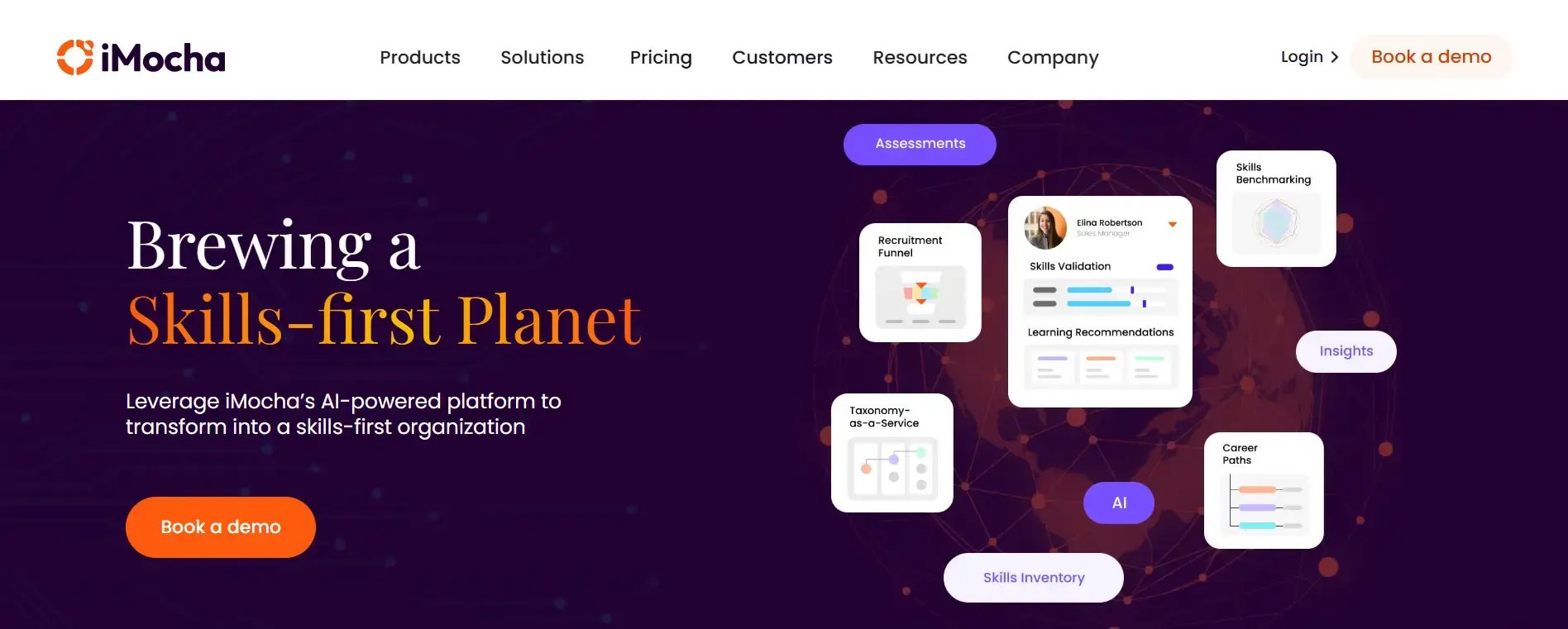Talent planning is the process of predicting, matching, and building a workforce to meet current and future business needs. It helps organizations have the right people with the right skills in the right roles at the right time.
In today's fast-moving economy, talent planning is important for business success, flexibility, and staying competitive. It helps HR leaders fix skill gaps, support internal career moves, and create strong teams that match company goals.
But manual talent planning often causes problems like mistakes, separate data, and slow decision-making. Talent planning software solves these problems by adding automation, smart features, and useful insights to the process.
What is Talent Planning software?
Talent planning software, also known as workforce planning or talent management software, is a type of application designed to help organizations manage their human resources effectively. These tools are essential for strategic HR management and aim to optimize the performance and development of employees.
Key features and functionalities typically include:
- Talent Acquisition: Developing strategies to attract and recruit the necessary talent to fill identified gaps.
- Workforce Analysis: Assessing the current workforce to understand the skills, capabilities, and demographics of employees.
- Skills Gap Analysis: Identifying discrepancies between current workforce capabilities and future needs.
- Talent Forecasting: Predicting future talent needs based on business goals, market trends, and workforce demographics.
- Succession Planning: Preparing for future leadership needs by identifying and developing internal candidates for key positions.
- Performance Management: Continuously assessing and managing employee performance to ensure alignment with organizational goals.
- Talent Development: Implementing training and development programs to enhance the skills and capabilities of the existing workforce.
- Retention Strategies: Creating initiatives to retain top talent and reduce turnover.
In this article, we’ll discuss the Top 6 Talent Planning Platforms that are a must-have for any organization. Let’s get started!
|
Table of contents |
Top 6 Talent Planning Software for 2025
1. iMocha
iMocha is a top AI-powered Skills Intelligence platform created to improve talent planning using clear, data-based insights. It helps companies build a skills-focused system by providing job structures, skill testing, and tools for comparing skills.
iMocha divides each job into main and extra skills using AI-based categories. It helps HR leaders clearly plan hiring, training, and internal moves.
Key Features:
- Job Role and Skills Organization: Make custom job structures based on your company’s needs.
- AI-based Skills Gap Analysis: Find skill gaps and create training plans for each department.
- Skills Benchmarking: Compare your workforce’s skills with market levels for better planning.
- Skills Validation: Check skills using tests, manager feedback, and data from training systems.
- Executive Dashboards: Easily see workforce skills and readiness for better decisions.
G2 Rating: 4.4/5 (267 reviews)
Founding Year: 2015
Pricing: Visit iMocha's pricing page for more details.
|
Manually gathering skills data, competencies, and proficiency scores is passé, get intelligent skills insights with iMocha's AI-enabled skills intelligence cloud. |
2.Workday
 Workday is a cloud-based talent planning tool that provides a unified solution for managing human resources, payroll, talent, and workforce planning. This system offers the agility to move quickly and the flexibility to meet the needs of all types of workers. With Workday, you can manage your workforce effectively and efficiently within a single system.
Workday is a cloud-based talent planning tool that provides a unified solution for managing human resources, payroll, talent, and workforce planning. This system offers the agility to move quickly and the flexibility to meet the needs of all types of workers. With Workday, you can manage your workforce effectively and efficiently within a single system.
Key Features:
- Intelligent Automation: Harnesses intelligent automation to save time by empowering your workforce and automating managerial processes. This enhances efficiency, allowing you to focus on productivity and engagement.
- Flexibility: Features a flexible system that enables easy resource reallocation and the establishment of new processes.
- Actionable Data: Delivers actionable insights for quicker decision-making. Visualize workforce costs and trends, identify root causes, and take action—all within a single platform.
- Worker-first: Prioritizes frontline workers by offering personalized and flexible experiences, empowering them with greater control over their work.
G2 Rating: 4/5 (1524 Reviews)
Founding Year: 2005
Pricing: Contact Workday for pricing
3. Sympa
 Sympa is a flexible and user-friendly talent planning tool designed to centralize all your people data and automate routine HR tasks, freeing up your HR teams for more strategic work. Whether your company operates locally or internationally, Sympa ensures you stay ahead of your future needs, so changes in your business or organization never catch you off guard. Sympa HR enables you to identify current and future skill and employee gaps, allowing you to prepare proactively.
Sympa is a flexible and user-friendly talent planning tool designed to centralize all your people data and automate routine HR tasks, freeing up your HR teams for more strategic work. Whether your company operates locally or internationally, Sympa ensures you stay ahead of your future needs, so changes in your business or organization never catch you off guard. Sympa HR enables you to identify current and future skill and employee gaps, allowing you to prepare proactively.
Key Features:
- Map and develop the competencies essential for your organization’s success.
- Understand your employees' skills and motivations.
- Conduct effective appraisals and performance development reviews (PDRs).
- Establish clear, organization-wide appraisal processes and ensure compliance.
- Identify where new talent is needed through gap analysis.
- Plan your talent development using reliable KPIs available through our powerful reporting tools.
G2 Rating: 3.5/5 (2 Reviews)
Founding Year: 2005
Pricing: Sympa has three pricing options: Grow, Essential, and Flex
4. MyTalentPlanner
 MyTalentPlanner is a talent planning tool designed to help organizations optimize their talent through a three-step process. First, develop a three-year strategic and financial vision to guide all talent decisions. Next, define the talent required to achieve this vision by creating detailed three-year talent plans. Finally, execute these plans by setting company goals and implementing ActOn plans in four-month sprints, each one bringing you closer to your strategic vision.
MyTalentPlanner is a talent planning tool designed to help organizations optimize their talent through a three-step process. First, develop a three-year strategic and financial vision to guide all talent decisions. Next, define the talent required to achieve this vision by creating detailed three-year talent plans. Finally, execute these plans by setting company goals and implementing ActOn plans in four-month sprints, each one bringing you closer to your strategic vision.
Key Features:
- Obtain strategic vision, financial vision, and other essential strategy documents.
- Gain visibility into your current organizational structure, talent vision, and talent plans.
- Enhance your ability to execute your strategy and talent plan through four-month sprints using Sprint Goals, ActON Plans, and Meetings.
- Conduct consistent and focused meetings to improve communication, transparency, accountability, and execution of your plans.
- Develop comprehensive talent plans at every level of the organization to nurture employees.
G2 Rating: NA
Founding Year: 2021
Pricing: Free demo available
|
Want to measure the extent of the skills gap among employees? Try iMocha's Skills Intelligence Cloud platform. |
5. Horsefly
 Horsefly Analytics provides global talent analytics through an easy-to-use talent planning platform. Horsefly gathers labor market data from around the globe to quickly create a real-time picture of the talent market. With its platform, users can rapidly and accurately benchmark gender gaps, understand supply and demand, and find hidden talent pools for any position or skill set their business needs.
Horsefly Analytics provides global talent analytics through an easy-to-use talent planning platform. Horsefly gathers labor market data from around the globe to quickly create a real-time picture of the talent market. With its platform, users can rapidly and accurately benchmark gender gaps, understand supply and demand, and find hidden talent pools for any position or skill set their business needs.
Key Features:
- Gain insights into talent availability and supply/demand in specific areas when considering new clients.
- Collaborate with hiring managers to develop market-appropriate remuneration and benefit packages.
- Obtain an overview of competitor activity in a particular geography.
- Utilize labor analytics software to gather valuable insights into employee performance, career aspirations, and development needs, fostering a culture of continuous learning and development within the organization.
G2 Rating: 5/5 (1 review)
Founding Year: 2011
Pricing: Custom packages based on organizational needs.
6. SAVIOM
SAVIOM is a strong talent management and workforce planning software. It helps companies match talent supply with demand by giving real-time visibility and better use of resources. It supports the exact assignment, planning, and development of employees.
Key Features:
- Resource Forecasting: Plan future talent needs based on upcoming projects.
- Role-based Scheduling: Assign the right employees to the right projects.
- Real-time Analytics: Track productivity and availability of global teams.
- Succession & Capacity Planning: Find future leadership gaps and maintain business continuity.
- Custom Workflows & Dashboards: Designed for companies with complex workforce structures.
G2 Rating: 4.5/5(1 Review)
Founded: 1999
Pricing: Custom pricing based on needs
| Explore how a skills-based talent strategy enhances talent planning, optimizes workforce potential, and drives organizational performance. |
Conclusion
In summary, talent planning software is essential for aligning skills with strategy, reducing hiring risks, and nurturing future-ready teams. Among these tools, iMocha stands out for its AI-powered Skills Intelligence Platform—offering real-time visibility into skills, automated job role mapping, and benchmarking that fuels smarter workforce decisions.
|
Are you struggling to identify the skills you need to stay ahead of your competition? Try iMocha! |
FAQs
1. Who uses talent planning tools?
Talent planning tools are used by HR leaders, managers, executives, and L&D teams to align workforce capabilities with business goals and support strategic hiring, development, and retention.
2. How does Talent Planning Software help the organization?
Talent planning software helps organizations forecast skill needs, close gaps, build succession pipelines, enhance internal mobility, and make data-driven decisions to future-proof the workforce effectively.
3. What is the difference between talent planning and talent mapping?
Talent planning is a long-term strategy for workforce readiness, while talent mapping focuses on identifying internal and external talent pools for immediate hiring or redeployment needs.
|
|


